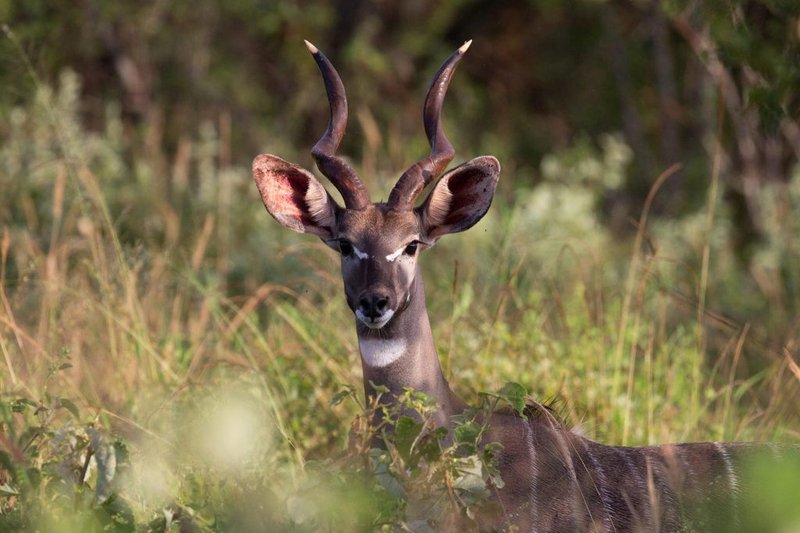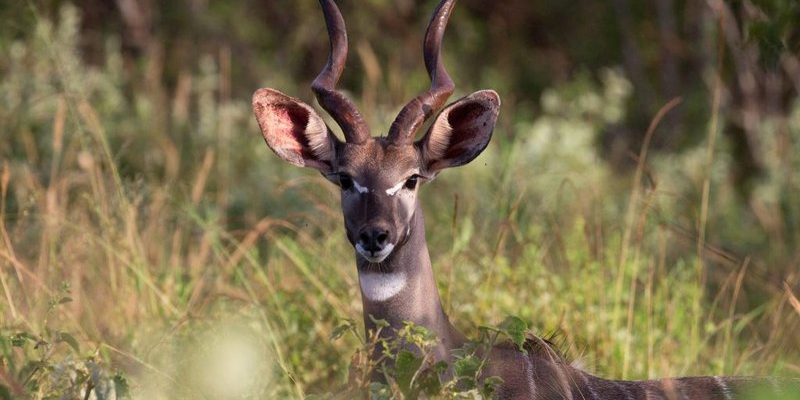
Let’s take a closer look at this enchanting species and explore some intriguing facts about it. You might be surprised by what you learn about their lifestyle, habitat, and unique characteristics. Grab your coffee, and let’s dive into the world of the lesser kudu!
1. What Is a Lesser Kudu?
The lesser kudu (Tragelaphus imberbis) is a medium-sized antelope that roams the woodlands and bushy areas of East and Southern Africa. Unlike its larger counterpart, the greater kudu, the lesser kudu is smaller and features a more graceful build. Imagine a delicate dancer, gliding through the underbrush with poise and elegance—that’s the lesser kudu for you.
You might be wondering what sets lesser kudus apart in the animal kingdom. For starters, they have a unique coat of reddish-brown fur, adorned with white stripes and spots. Males are especially striking, with long, spiral horns that can grow up to three feet long. Their stunning appearance is not just for show; it helps them blend into their environment, making them less visible to predators.
2. Habitat and Range
Lesser kudus typically inhabit dense bush and woodlands, favoring areas with plenty of cover. These habitats provide them with the food and protection they need. They are mainly found in countries like Kenya, Tanzania, and Zimbabwe, thriving in regions that offer both moisture and privacy.
Their preference for thick vegetation is no accident. The less densely populated areas allow them to evade predators such as lions and leopards. Just think of it as finding a cozy café in a quiet corner of your favorite city—perfect for enjoying peace and tranquility away from the hustle and bustle!
3. Social Structure and Behavior
When it comes to social behavior, lesser kudus are a bit of introverts. While they can be seen in small groups, they often prefer solitude or staying close to family members. Typically, a mother and her young will stick together, while adult males are generally more solitary, roaming around to mark their territory.
Their behavior is fascinating to observe. Lesser kudus have a unique way of communicating, using body language and soft vocalizations. When they sense danger, they can freeze in place to avoid detection, blending expertly into their surroundings. It’s like playing a game of hide and seek, where they are champions at being unseen!
4. Diet and Feeding Habits
Lesser kudus are herbivores, primarily browsing on leaves, shoots, fruits, and flowers. Their long, slender legs and flexible necks make it easy for them to reach higher foliage. Imagine a selective eater at a buffet, choosing only the freshest, most tender greens and fruits!
They’re also known for their selective feeding habits, often picking the most nutritious parts of the plants they consume. This strategy not only helps them stay healthy but also plays a role in their habitat, as their eating habits can influence plant growth in their environment.
5. Unique Antler Formation
One of the most striking features of male lesser kudus is their spiral horns. You might think of them as nature’s elegant sculptures, curling upwards from their heads. These horns are not just for show; they play a vital role in mating rituals and establishing dominance among males.
When two males encounter each other, they often engage in a show of strength, using their horns in displays or sparring matches. This behavior ensures that the strongest males have the opportunity to mate, maintaining the health of the population. It’s like a natural audition, where only the best performers get to pass on their genes!
6. Breeding and Reproduction
Lesser kudus have a unique breeding cycle that adds to their mystique. Female kudus usually give birth to a single calf after a gestation period of about seven months. When it’s time to deliver, mothers search for a safe and secluded spot to give birth, ensuring their young have the best chance of survival.
The calves are born with a spotted coat, which helps them blend into the foliage, making them less visible to predators. As they grow, they begin to join their mothers in foraging, learning the ropes of survival in the wild. It’s like a rite of passage, where they slowly transition from vulnerable little ones to confident foragers.
7. Conservation Status
While lesser kudus are currently classified as “Least Concern” by the International Union for Conservation of Nature (IUCN), their populations face threats from habitat loss and hunting. Clearing forests for agriculture or urban development can take away their natural homes, putting them at risk.
Conservation efforts are underway to help protect these beautiful animals. Protected areas and national parks play a crucial role in their survival, allowing them to thrive in a safe environment. It’s important for us to recognize that every species, like the lesser kudu, plays a role in maintaining the balance of their ecosystems.
8. Cultural Significance
Lesser kudus hold cultural significance in several African communities. Many local tribes view these animals as symbols of grace and agility, often reflected in their art and folklore. The kudu has become a part of the local identity, representing the beauty of the natural world.
In some cultures, the lesser kudu is also seen as a source of inspiration. Their elegant movements and the way they navigate their environment can be a reminder of the importance of balance and harmony in life.
9. Adaptations for Survival
The lesser kudu has developed several adaptations that aid in its survival. Their large ears are not just for show; they provide excellent hearing, allowing them to detect predators before it’s too late. Plus, their ability to remain motionless when they sense danger is a fascinating survival tactic.
Another interesting adaptation is their slender build. This physical structure allows them to move quickly and gracefully through thick vegetation, which is crucial for escaping threats. It’s like having the perfect outfit for every occasion—ideal for blending in and avoiding trouble!
10. The Role of Lesser Kudu in Ecosystems
Lesser kudus play a vital role in their ecosystems, particularly as seed dispersers. When they eat fruits and leaves, they help in the growth and spread of various plants. This relationship is essential for maintaining healthy habitats and promoting biodiversity.
Moreover, as prey for larger predators, they contribute to the food web and support the overall balance of the ecosystem. In a way, lesser kudus serve as unsung heroes, quietly supporting their environment while going about their lives.
In conclusion, the lesser kudu, with its elegance and charm, is more than just another antelope in the wild. It has fascinating traits and behaviors that contribute to the richness of Africa’s biodiversity. By understanding and protecting these incredible animals, we acknowledge the intricate connections that bind all living things together. So, the next time you hear about African wildlife, remember the lesser kudu—a graceful dancer in the vast theater of nature.

